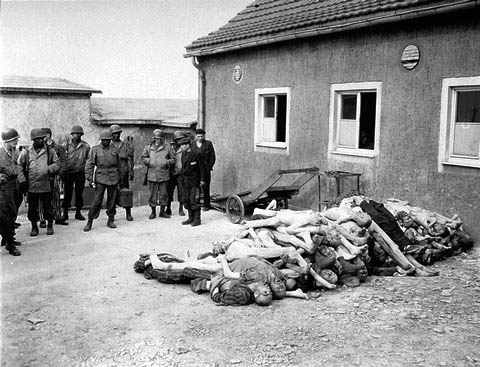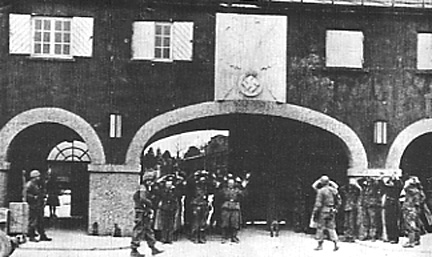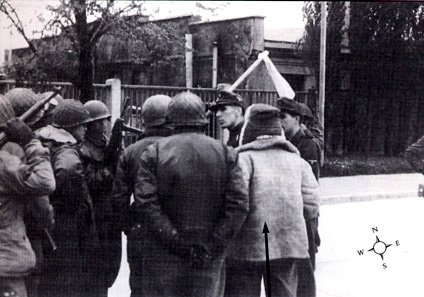Did African American soldiers liberate
Dachau?
Previous

Dachau prisoners wave
their hats at the American liberators
The U.S. Army credits the 45th Thunderbird
Division, the 42nd Rainbow Division and the 20th Armored Division
as the liberators of the Dachau concentration camp on April 29,
1945. There were no African-American soldiers in these three
divisions because the American Army was segregated during World
War II. However, a few African-American veterans have claimed
that they were there when the main Dachau concentration camp
was liberated on April 29, 1945. Other veterans, including Lt.
Col. Felix Sparks of the 45th Thunderbird Division, maintain
that there were no black soldiers among the liberators of Dachau.
According to a news article in the Boston
Globe on October 12, 2000, Dr. Paul Parks was slated to receive
the Raoul Wallenberg Award from B'nai B'rith, but the plan to
honor Parks for his role in liberating Dachau was canceled after
retired Army Col. Hugh F. Foster III informed B'nai B'rith spokesman
Eric Rozenman that there is no military record of Dr. Parks being
at Dachau when the camp was liberated.
Dr. Parks served with the 365th Engineer
Regiment from 1943 to 1945; he has acknowledged that his regiment
was not at Dachau on April 29, 1945, but he told a Boston Globe
reporter that he was on a special assignment to deactivate mines
throughout France and that is how he came to be at Dachau when
the camp was liberated.
Dr. Parks claimed that his military records
were lost in a fire in 1973, which means that his story of being
with the soldiers who stormed the beach at Normandy on D-Day
also cannot be confirmed. Foster claims that the 365th Engineer
Regiment was in England on D-Day.
According to the Boston Globe article,
"Parks has been among the most prominent black leaders in
Massachusetts over the last half century. He was vice president
of the Boston branch of the National Association for the Advancement
of Colored People in the 1960s, education secretary under then-Gov.
Michael Dukakis and founder of a program that for 34 years has
bused black children from Boston to suburban schools."
In a book entitled "The Last Days," about a Steven
Spielberg documentary with the same name, Dr. Parks said the
following, regarding why African-American soldiers were chosen
to liberate the concentration camps:
"About our role near the end
of the war, though I have no proof of this, a Bostonian who was
on General Eisenhower's staff told me that the decision was taken
that, wherever possible, the liberators of the camps would be
black soldiers - United States soldiers. He said that they had
come to the conclusion that if the people who were in the camps
saw black soldiers they would feel more at ease with them. It
wasn't some sort of weird cruel trick - people who saw us come
into the camps, some of them my friends now, have told me, 'We
knew when we saw you that you weren't Germans....we knew you
had to be Americans' - so it did work."
On November 11, 1992, a TV documentary
was aired by PBS on nationwide TV in honor of Veterans' Day.
The title of the documentary was the same as the title of the
book on which it was based: "Liberators: Fighting On Two
Fronts In WWII." The book was written by Lou Potter with
some help from William Miles and Nina Rosenblum, the co-producers
who made the film and the theatrical version. The film was produced
by Miles Educational Film Production in New York City. The book
was published by Harcourt Brace Jovanovich in late 1992. Also
included in this lavish project was a workbook for High School
students.
Liberators: Fighting on Two Fronts in
World War II was exposed as a fraud within weeks of its debut,
but the story still lives on.
The documentary, which was touted as
historically accurate, claimed that the 761st Tank Battalion,
attached to the 71st Division, liberated both Buchenwald and
Dachau. Veterans who participated in the liberation of these
camps deny that the soldiers of the 761st Tank Battalion were
there, and the US Army does not recognize the 761st as liberators
of any of the Nazi camps. Only divisions can be officially honored
as liberators; the 71st Division is credited with being the liberators
of the Mauthausen sub-camp, called Gunskirchen, in Austria, where
starving prisoners were set free and allowed to plunder the nearby
town of Lambach.
The soldiers in the 761st Tank Battalion
were all African-Americans; the title of the book and the PBS
film refers to the fact that black soldiers had to fight discrimination
by Americans on the home front, while at the same time, they
were fighting on the battle front in Europe to end the racial
discrimination by the Nazis.
Basketball legend Kareem Abdul-Jabbar
saw the 1992 PBS documentary and decided to do some research
on the subject. With the help of the United Jewish Federation
and researchers in Israel, he learned that it was another all-black
unit, the 183rd Combat Engineers Battalion, which had liberated
Buchenwald, but the 761st Tank Battalion had liberated Dachau.

Soldiers of the 183rd
Combat Entgineers Battalion at Buchenwald, April 16, 1945
The US Army credits the 6th Armored Division
with the liberation of Buchenwald on April 11, 1945; the 183rd
Combat Engineers Battalion delivered some supplies five days
later, too late to meet the requirement to be considered liberators
of a camp. According to the rules, only a division which arrived
within 48 hours, of the gates to a camp being opened, can claim
that it participated in the liberation.
When Abdul-Jabbar discovered that his
surrogate uncle, Leonard "Smitty" Smith, was with the
761st, he wrote a book, with the help of writer Anthony Walton.
The book is entitled "Brothers in Arms: The Epic Story of
the 761st Tank Battalion, WWII's Forgotten Heroes."
According to Abdul-Jabbar's book, "Smitty"
was riding in the first tank to go through the main gate at Dachau;
one of "Smitty's" comrades saw a jar full of eyeballs
at Dachau.
Although there are numerous photos of
the liberation of Dachau, none of the photos show any tanks at
Dachau that day. The 20th Armored Division of the U.S. Seventh
Army arrived at Dachau on April 29, 1945, but their tanks were
unable to cross the Amper river at Dachau because the bridge
had been destroyed by the Germans. All the soldiers who were
involved in the liberation of Dachau arrived at the camp on foot
or in light vehicles that were able to cross a railroad bridge
that had been only partially destroyed.

SS soldiers surrendered
at the main gate into Dachau complex
The photo above shows the main gate at
the Dachau complex on April 29, 1945, the day that SS soldiers
at Dachau surrendered to the 42nd Infantry Division of the US
Seventh Army. Note that there are no tanks in the photo.
The photo below shows 2nd Lt. Heinrich
Wicker surrendering the camp to Brig. Gen. Henning Linden of
the 42nd Infantry Division. No tanks in this picture either.

SS 2nd Lt. Heinrich
Wicker surrenders camp to Brig. Gen. Henning Linden
Claims
made by Japanese soldiers
Which
Jewish Chaplain first entered Dachau?
Who
entered Dachau first?
The
account of Frank Burns of the 42nd Division
Back to Dachau
Liberation
Back to Table
of Contents
Home
This page was last updated on November
23, 2009
Did African American soldiers liberate Dachau?Previous The U.S. Army credits the 45th Thunderbird Division, the 42nd Rainbow Division and the 20th Armored Division as the liberators of the Dachau concentration camp on April 29, 1945. There were no African-American soldiers in these three divisions because the American Army was segregated during World War II. However, a few African-American veterans have claimed that they were there when the main Dachau concentration camp was liberated on April 29, 1945. Other veterans, including Lt. Col. Felix Sparks of the 45th Thunderbird Division, maintain that there were no black soldiers among the liberators of Dachau. According to a news article in the Boston Globe on October 12, 2000, Dr. Paul Parks was slated to receive the Raoul Wallenberg Award from B'nai B'rith, but the plan to honor Parks for his role in liberating Dachau was canceled after retired Army Col. Hugh F. Foster III informed B'nai B'rith spokesman Eric Rozenman that there is no military record of Dr. Parks being at Dachau when the camp was liberated. Dr. Parks served with the 365th Engineer Regiment from 1943 to 1945; he has acknowledged that his regiment was not at Dachau on April 29, 1945, but he told a Boston Globe reporter that he was on a special assignment to deactivate mines throughout France and that is how he came to be at Dachau when the camp was liberated. Dr. Parks claimed that his military records were lost in a fire in 1973, which means that his story of being with the soldiers who stormed the beach at Normandy on D-Day also cannot be confirmed. Foster claims that the 365th Engineer Regiment was in England on D-Day. According to the Boston Globe article,
"Parks has been among the most prominent black leaders in
Massachusetts over the last half century. He was vice president
of the Boston branch of the National Association for the Advancement
of Colored People in the 1960s, education secretary under then-Gov.
Michael Dukakis and founder of a program that for 34 years has
bused black children from Boston to suburban schools." "About our role near the end of the war, though I have no proof of this, a Bostonian who was on General Eisenhower's staff told me that the decision was taken that, wherever possible, the liberators of the camps would be black soldiers - United States soldiers. He said that they had come to the conclusion that if the people who were in the camps saw black soldiers they would feel more at ease with them. It wasn't some sort of weird cruel trick - people who saw us come into the camps, some of them my friends now, have told me, 'We knew when we saw you that you weren't Germans....we knew you had to be Americans' - so it did work." On November 11, 1992, a TV documentary was aired by PBS on nationwide TV in honor of Veterans' Day. The title of the documentary was the same as the title of the book on which it was based: "Liberators: Fighting On Two Fronts In WWII." The book was written by Lou Potter with some help from William Miles and Nina Rosenblum, the co-producers who made the film and the theatrical version. The film was produced by Miles Educational Film Production in New York City. The book was published by Harcourt Brace Jovanovich in late 1992. Also included in this lavish project was a workbook for High School students. Liberators: Fighting on Two Fronts in World War II was exposed as a fraud within weeks of its debut, but the story still lives on. The documentary, which was touted as historically accurate, claimed that the 761st Tank Battalion, attached to the 71st Division, liberated both Buchenwald and Dachau. Veterans who participated in the liberation of these camps deny that the soldiers of the 761st Tank Battalion were there, and the US Army does not recognize the 761st as liberators of any of the Nazi camps. Only divisions can be officially honored as liberators; the 71st Division is credited with being the liberators of the Mauthausen sub-camp, called Gunskirchen, in Austria, where starving prisoners were set free and allowed to plunder the nearby town of Lambach. The soldiers in the 761st Tank Battalion were all African-Americans; the title of the book and the PBS film refers to the fact that black soldiers had to fight discrimination by Americans on the home front, while at the same time, they were fighting on the battle front in Europe to end the racial discrimination by the Nazis. Basketball legend Kareem Abdul-Jabbar saw the 1992 PBS documentary and decided to do some research on the subject. With the help of the United Jewish Federation and researchers in Israel, he learned that it was another all-black unit, the 183rd Combat Engineers Battalion, which had liberated Buchenwald, but the 761st Tank Battalion had liberated Dachau.  The US Army credits the 6th Armored Division with the liberation of Buchenwald on April 11, 1945; the 183rd Combat Engineers Battalion delivered some supplies five days later, too late to meet the requirement to be considered liberators of a camp. According to the rules, only a division which arrived within 48 hours, of the gates to a camp being opened, can claim that it participated in the liberation. When Abdul-Jabbar discovered that his surrogate uncle, Leonard "Smitty" Smith, was with the 761st, he wrote a book, with the help of writer Anthony Walton. The book is entitled "Brothers in Arms: The Epic Story of the 761st Tank Battalion, WWII's Forgotten Heroes." According to Abdul-Jabbar's book, "Smitty" was riding in the first tank to go through the main gate at Dachau; one of "Smitty's" comrades saw a jar full of eyeballs at Dachau. Although there are numerous photos of the liberation of Dachau, none of the photos show any tanks at Dachau that day. The 20th Armored Division of the U.S. Seventh Army arrived at Dachau on April 29, 1945, but their tanks were unable to cross the Amper river at Dachau because the bridge had been destroyed by the Germans. All the soldiers who were involved in the liberation of Dachau arrived at the camp on foot or in light vehicles that were able to cross a railroad bridge that had been only partially destroyed.  The photo above shows the main gate at the Dachau complex on April 29, 1945, the day that SS soldiers at Dachau surrendered to the 42nd Infantry Division of the US Seventh Army. Note that there are no tanks in the photo. The photo below shows 2nd Lt. Heinrich Wicker surrendering the camp to Brig. Gen. Henning Linden of the 42nd Infantry Division. No tanks in this picture either.  Claims made by Japanese soldiersWhich Jewish Chaplain first entered Dachau?Who entered Dachau first?The account of Frank Burns of the 42nd DivisionBack to Dachau LiberationBack to Table of ContentsHomeThis page was last updated on November 23, 2009 |